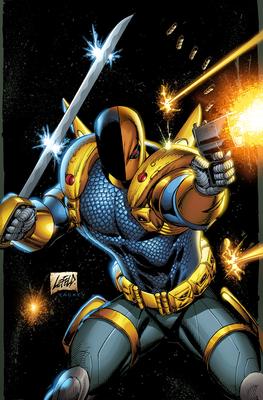Boom! Wham! Pow! The ComiQuad is a column dedicated to the spandex-laden world of comics and superheroes. It goes up each Tuesday and will alternate between comic book reviews and other comic book news. Reviews shall try to be spoiler-free. Zam!
Ladies and gentlemen. Just a few days ago, the Internet exploded.
Well, at the very least, the comic book district of Internet exploded.
Was it thanks to the release of teaser images for Marvel’s upcoming Avengers VS. X-Men series? Was it due to the shocking, although strangely predictable, cancellations by DC Comics? Nope.
It was all thanks to Robert Liefeld. He, a longtime comic book artist and writer, was announced to be writing and drawing for some DC comic books. And that, my friends, is when the Internet exploded.
Robert Liefeld
Liefeld, like the other creator who will be discussed in this post, is one of the single most polarizing people in the entire comic book industry. Just mentioning his name will summon forth an army of the most vitriolic of venom-spitters and the most ardent of defenders.
This controversial man worked extensively with Marvel during the 1980s and eventually went on to create the popular anti-hero character of Deadpool. During the 1990s, Liefeld, alongside several other artists, left Marvel to create Image Comics, a comic book publisher famous for fostering numerous creator-owned comic book titles. Creators would not need to surrender their characters to a company’s copyright.
In creating Image Comics, Liefeld changed the industry by giving comic book creators the opportunity to exist independently outside of DC Comics and Marvel.
So why is a man who has worked in the industry for years, created a popular fourth-wall-breaking anti-hero and built a creator-owned movement so polarizing?
Because, according to his detractors, the man hates feet. And he loves pouches. He also enjoys muscles on top of muscles on top of even more muscles. It also doesn’t hurt if there are guns sticking out everywhere and no body part is at all proportional. There are even websites dedicated to his widely criticized muscle/gun/pouch cornucopias.

What tends to irk critics even more is that, despite being the most controversial artist in comics, he never goes away. Just recently, Hawk and Dove, the title he does art for and will soon be writing for, is getting canceled. Fortunately for Liefeld and his fans, he will not be unemployed.
Days after the cancellation announcement, Liefeld was made both artist and writer for Deathstroke and plotter (pseudo-writer) for The Savage Hawkman and Grifter.
And that is when the Internet exploded. A man who has his book canceled is rewarded with even more employment. Maybe these other books just need less feet in them.
Scott Lobdell
Not that long ago, another man with a long history in the comic book industry came along, hit an unintentional tripwire on the way to work, and again, exploded the World Wide Web.
Prior to the nitrous incident, Lobdell, like Liefeld, worked many years at Marvel Studios. He wrote for the X-Men, the Fantastic Four, Iron Man and other superheroes. He, again like Liefeld, worked briefly with Image Comics.
What’s unique about Lobdell’s accidental Internet implosion is that it was triggered by some unique tango dance-step of “one step forward, and two steps back.”
When DC Comics rebooted their entire universe in the New 52 universe relaunch, Lobdell was assigned to write for three titles: Superboy, Red Hood and the Outlaws and Teen Titans.
In his title Teen Titans, he made some incredibly progressive forward-moving decisions in the creation of the seven-person team. Instead of filling it to the brim with old faces, he decided to change things up by creating two new members and raising the status of another all in the name of diversity.
Skitter, an African-American female, and Bunker, a homosexual latino male, are Lobdell’s brand new creations. Solstice, an Indian female, was once lost in obscurity and has now been brought into one of DC’s top-selling books.
In an interview with Comicvine, Lobdell even went out to say, “I have grown tired of seeing ‘Young White Male’ superheroes (I’ve said in other interviews that if the industry never creates another we would all be okay! LOL!)”
That’s one of the more progressive attitudes the comic book industry needs. Unfortunately, no one noticed any of that because Lobdell, in the eyes of his detractors, took a running leap backwards in his title Red Hood and the Outlaws (RHatO).
RHatO features Starfire, a female alien made popular by her comic book history and a widely-viewed cartoon show on Cartoon Network. Starfire in RHatO, according to her critics however, bore very little personality resemblance to any previous incarnation of the character.

The old Starfire embraced and loved all people with an optimistic outlook on life. This Starfire claims she can’t tell humans apart, is apathetic about remembering any of her former friends, waltzes around in a metal bikini or string bikini that was initially intended to be transparent and boasts about having sex with both of the male leads.
She also feels love, one of her past quintessential qualities, has nothing to do with sex or interactions with humans.
Critics were not happy about any of these changes. And thus began a bloody civil war between fans of better female portrayal in comics and fans of enormous cleavage in comics. And, much like all wars on the Internet, absolutely no one won, and everyone was raging angry.
Depending on who you ask, Liefeld is a legacy in the comic book industry, and Lobdell is incredibly forward thinking for creating some new role models for gay males, latinos, African-Americans and those of Indian descent.
Or Liefeld is an artistic monstrosity and Lobdell is the guy who ruined everyone’s beloved alien princess.
Safe to say, both of them are looking forward to the next guy who hits the Internet’s “self-destruct button.”

Liefeld does suck, it’s true!
But that doesn’t matter to ANYONE at DC, right?